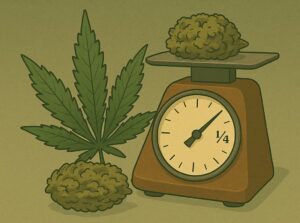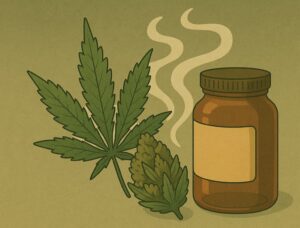Wondering what does weed smell like?
If you’ve ever walked past someone lighting up, you know cannabis has one of the most unmistakable scents in the world. Some people love its earthy, skunky aroma, while others find it overpowering.
But what exactly causes that smell, and why does it vary so much from one strain to another?
NorCal Holistics believes that understanding the smell of cannabis helps consumers appreciate its complexity and quality. From terpenes to curing methods, there’s a fascinating science behind that distinct aroma.
Let’s break down what weed smells like, why it smells that way, and even how synthetic cannabis compares.
The Science Behind the Smell
The signature scent of cannabis comes primarily from terpenes, a natural aromatic compounds also found in fruits, flowers, and spices. While cannabinoids like THC and CBD are responsible for effects, they’re odorless.
Terpenes, however, produce cannabis’ diverse range of smells, from sweet citrus to sharp pine.
More than 200 different terpenes have been identified in cannabis. Some of the most common include:
- Myrcene: earthy, herbal, musky (also found in thyme and mango).
- Limonene: citrusy, zesty, uplifting.
- Pinene: fresh pine and woodsy tones.
- Caryophyllene: peppery, spicy, with a bite.
Research has shown that myrcene is the most abundant terpene in cannabis, appearing in up to 20% of strains. This is why many strains share that earthy, musky base note.
What Does Weed Smell Like?
Weed has a pungent, skunky, and earthy aroma that’s hard to mistake. That “skunky” note is so iconic that even people who don’t use cannabis can often recognize it immediately.
But beyond that baseline, cannabis offers a wide range of scents depending on the strain and terpene profile.
Some of the most common ways people describe the smell of weed include:
- Earthy and musky – like damp soil or cloves.
- Citrusy and fresh – reminiscent of lemons, oranges, or grapefruit.
- Piney and herbal – sharp and clean, like walking through a forest.
- Sweet or fruity – with berry, tropical fruit, or candy-like notes.
- Spicy and peppery – similar to black pepper or cinnamon.
- Diesel or fuel-like – sharp, chemical-like aromas that certain strains are famous for (Sour Diesel, for instance).
In short, the smell of cannabis is complex, layered, and often subjective. What one person calls “skunky,” another may interpret as “earthy” or “herbal.” That complexity is part of what makes cannabis such an intriguing plant to explore.
How Strains Differ in Smell?
Not all weed smells the same.
In fact, aroma is one of the key ways to differentiate strains. While the traditional indica/sativa categories are debated scientifically, consumer perception still associates them with certain aromas:
- Indica strains: typically musky, earthy, or skunky.
- Sativa strains: often citrusy, fruity, or floral.
- Hybrids: complex combinations depending on their lineage.
For example:
- Blue Dream is known for its sweet berry scent.
- Wedding Cake offers vanilla-like, dessert aromas.
- Sour Diesel lives up to its name with a pungent, fuel-like smell.
It’s not just anecdotal: In a controlled consumer trial, roughly 60% of cannabis users report using aroma as a criterion when choosing a flower, and ‘pleasant subjective aroma’. This shows just how central smell is to the cannabis experience.
External Factors That Change the Smell
Even the best strain can lose its scent or take on a strange odor if not handled properly. Several external factors influence the way cannabis smells:
- Harvesting & curing: Proper curing enhances terpene expression, while rushed curing can result in buds that smell grassy or like hay.
- Storage: Exposure to air, light, or heat can degrade terpenes quickly. Studies show that up to 51.6% of terpene content can be lost in poorly stored cannabis.
- Consumption method:
- Smoking tends to release the strongest, skunkiest smells.
- Vaping produces cleaner, often sweeter aromas.
- Edibles usually mask the scent, though some herbal undertones remain.
NorCal Holistics follows proper storage and delivery practices to preserve terpene integrity so customers receive fresh, aromatic cannabis every time. If you are looking for premium cannabis at a great price, check out the best weed delivery deals that we offer.
Why Weed Smell Matters
The smell of cannabis has cultural, social, and even legal significance. Here’s why:
- Consumer experience: Aroma is tied to flavor and effect. The “entourage effect” suggests that terpenes work alongside cannabinoids to shape how cannabis feels.
- Social perception: Some people enjoy the pungency, while others find it invasive.
- Legal implications: Historically, the smell of cannabis was used as probable cause for law enforcement. While this is shifting in states with legalization, odor remains a complex issue.
Ultimately, the smell of cannabis is more than a quirk. It’s a central part of the plant’s identity and how society interacts with it.
What Does Synthetic Weed Smell Like?
Synthetic cannabis (often sold under names like “K2” or “Spice”) is a very different story. Unlike natural cannabis, which gets its smell from terpenes, synthetic weed consists of dried plant matter sprayed with lab-made chemicals.
As a result, it does not smell like real cannabis. Instead, users describe it as:
- Harsh or chemical-like.
- Resembling burnt herbs or incense.
- Sometimes carrying a plastic or solvent undertone.
The off-putting odor isn’t the only issue. Synthetic cannabinoids have been linked to severe health risks. In fact, the CDC reported over 2,300 emergency department visits in 2016 alone due to synthetic cannabinoid use.
If cannabis smells “chemical” or doesn’t resemble the natural range of earthy, citrusy, or floral tones, it’s a red flag that it may not be genuine.
Describing Weed Smell Like a Pro
For those new to cannabis, describing aroma can feel overwhelming. But just like wine or coffee tasting, developing a “nose” for cannabis is a skill.
Here are some tips:
- Start with categories: earthy, citrusy, piney, sweet, spicy, or floral.
- Get specific: diesel, berry, chocolate, vanilla, or tropical fruit notes.
- Compare with everyday scents: lemon peel, fresh pine needles, black pepper, or lavender.
Cannabis sommeliers, sometimes called “cannasseurs”, use this vocabulary to evaluate strains.
Explore Aromas with NorCal Holistics
At NorCal Holistics, we’re passionate about helping customers experience the full spectrum of cannabis aromas and flavors. As a licensed weed delivery in Sacramento, we specialize in bringing high-quality, lab-tested products straight to your door.
Our menu includes:
- Premium flower with terpene-rich profiles ranging from earthy indicas to citrusy sativas.
- Pre-rolls and bundles for those who want ready-to-enjoy options or variety packs that highlight different scents.
- Vape cartridges and concentrates for cleaner, more nuanced aromas.
- Edibles and tinctures that balance discreet enjoyment with subtle herbal notes.
- Topicals and accessories for alternative cannabis experiences.
We carry top California brands like Alien Labs, West Coast Cure, Cannabiotix, and Pacific Stone, ensuring customers can explore a wide range of terpene expressions. Visit our shop to explore all the products that we can bring right at your doorstep.
Conclusion
So, what does weed smell like? The answer is: it depends. From earthy myrcene-heavy strains to citrusy limonene-rich varieties, cannabis offers a complex spectrum of aromas shaped by terpenes, strain genetics, and handling.
External factors like curing, storage, and consumption method further influence how cannabis smells, while synthetic products reveal themselves with harsh, chemical odors.
Smell is more than just a sensory detail — it’s part of cannabis’ cultural story, its consumer appeal, and even its legal context. For enthusiasts, learning to identify and describe different scents deepens appreciation and helps in finding the right strain.



